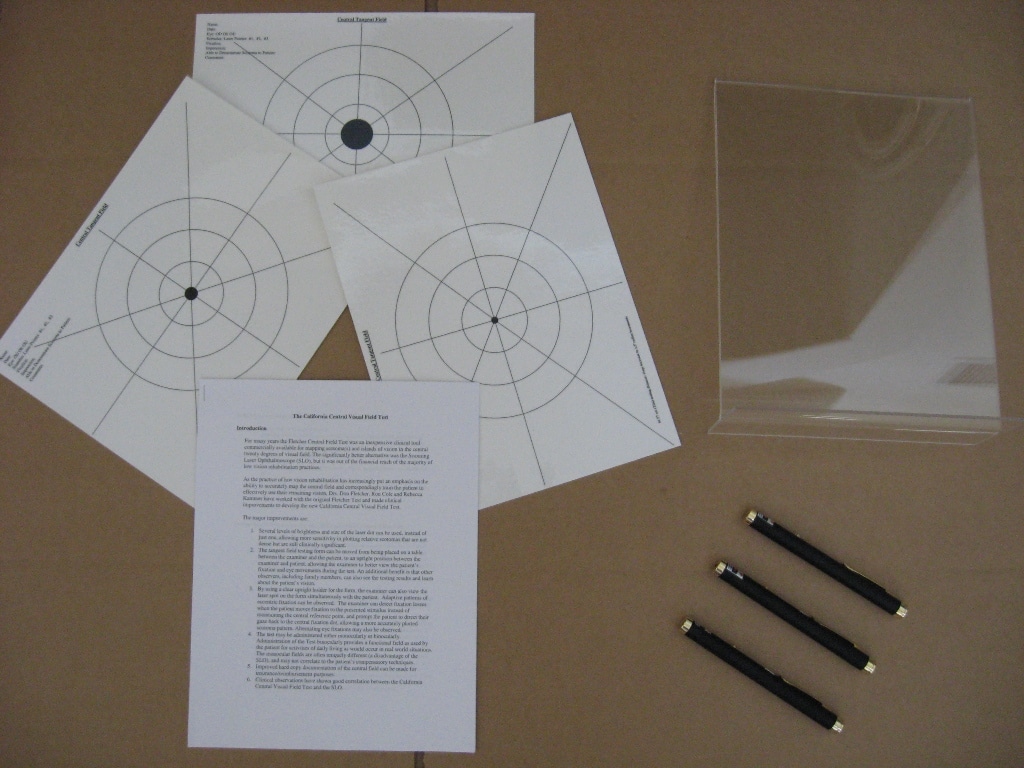California Central Visual Field Test
Indications for Using the California Central Visual Field Test
1. Suspected central field defects
2. Macular disease including age-related macular degeneration and diabetic retinopathy (ischemic maculopathy and post focal laser photocoagulation)
3. Optic neuropathies, including glaucoma
4. Difficulty with word and letter misidentification in spite of adequate magnification
5. Difficulty with page navigation (losing place, skipping lines, rereading text, etc.)
6. Slow reading that may be caused by scotomas
7. Need for the education of the patient in location of scotomas and compensatory eye movements to avoid scotomas
$190.50
Description
For many years the Fletcher Central Field Test was an inexpensive clinical tool commercially available for mapping scotoma(s) and islands of vision in the central twenty degrees of visual field. The significantly better alternative was the Scanning Laser Ophthalmoscope (SLO), but it was out of the financial reach of the majority of low vision rehabilitation practices.
As the practice of low vision rehabilitation has increasingly put an emphasis on the ability to accurately map the central field and correspondingly train the patient to effectively use their remaining vision, Drs. Don Fletcher, Ron Cole and Rebecca Kammer have worked with the original Fletcher Test and made clinical improvements to develop the new California Central Visual Field Test.
The major improvements are:
1. Several levels of brightness and size of the laser dot can be used, instead of just one, allowing more sensitivity in plotting relative scotomas that are not dense but are still clinically significant.
2. The tangent field testing form can be moved from being placed on a table between the examiner and the patient, to an upright position between the examiner and patient, allowing the examiner to better view the patient’s fixation and eye movements during the test. An additional benefit is that other observers, including family members, can also see the testing results and learn about the patient’s vision.
3. By using a clear upright holder for the form, the examiner can also view the laser spot on the form simultaneously with the patient. Adaptive patterns of eccentric fixation can be observed. The examiner can detect fixation losses when the patient moves fixation to the presented stimulus instead of maintaining the central reference point, and prompt the patient to direct their gaze back to the central fixation dot, allowing a more accurately plotted scotoma pattern. Alternating eye fixations may also be observed.
4. The test may be administered either monocularly or binocularly. Administration of the Test binocularly provides a functional field as used by the patient for activities of daily living as would occur in real world situations. The monocular fields are often uniquely different (a disSMARTMag® of the SLO), and may not correlate to the patient’s compensatory techniques. Improved hard copy documentation of the central field can be made for insurance/reimbursement purposes.
5. Clinical observations have shown good correlation between the California Central Visual Field Test and the SLO.
Contents of the CCVFT
1. Upright plastic tangent field form holder
2. Three unique reproducible tangent field forms (varying sized central fixation dots) for testing and scoring
3. Three unique laser pens (each has a different colored metal housing) offering three levels of brightness and size of the laser dot
4. Detailed instructions written by Drs. Fletcher, Cole and Kammer.
Indications for Using the California Central Visual Field Test
1. Suspected central field defects
2. Macular disease including age-related macular degeneration and diabetic retinopathy (ischemic maculopathy and post focal laser photocoagulation)
3. Optic neuropathies, including glaucoma
4. Difficulty with word and letter misidentification in spite of adequate magnification
5. Difficulty with page navigation (losing place, skipping lines, rereading text, etc.)
6. Slow reading that may be caused by scotomas
7. Need for education of patient in location of scotomas and compensatory eye movements to avoid scotomas
Developed by:
Donald Fletcher, MD (Primary)
Ophthalmologist,
California Medical Center,
San Francisco, CA USA
Ronald Cole, MD
Ophthalmologist,
MVT Vision Rehabilitation Center,
Sacramento, CA USA
Rebecca Kammer, OD
Chief, Low Vision Center,
Southern California College of Optometry,
Fullerton, CA USA





